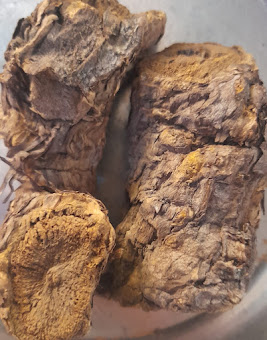Rheum Emodi – Rhubarb Roots – Revand Chini / Khatai: An Overview
Introduction:
Rheum Emodi, commonly known as Indian Rhubarb or Himalayan Rhubarb, is a perennial herbaceous plant belonging to the family Polygonaceae. It is native to the Himalayan region and grows at high altitudes in countries like India, Pakistan, Bhutan, and Nepal. Rheum Emodi has large, broad leaves and stout, fleshy roots. The plant can grow up to 1-2 meters in height. The flowers are small, greenish, and grow in clusters. The roots are thick and fleshy, typically used in traditional medicine.


Botanical Name:
Rheum Emodi Wall. ex Meissn.
Family:
Polygonaceae
Urdu Name:
Rewand Chini, Bekh Rebas, Tursak, Revand Khatai
English Name:
Rhubarb, Rheum
Parts Used:
Rhizome.
Temperament:
Compound temperament (Murakkab al Quwa).
Geographical Source:
Pakistan, India, China, Asam, Nepal.
Organoleptic Evaluation:
Color: Greyish brown to dark brown.
Odor: Characteristics, Earthy and slightly bitter.
Taste: Bitter, astringent, slightly sweet.
Texture: Rough , fibrous , crunchy in raw form.
Appearance: Long , thin, cylindrical roots with a rough surface.
Pharmacological Actions / Functions:
Stimulant and liver tonic
Primarily: mild (anthraquinone)
Purgative
Secondarily: stomachic and astringent in relatively small dose
Diuretic and emmenagogue
Deobstruent (especially for liver and intestines).
Specific Action:
Deobstruent and purgative for the viscid,
Sticky humours or by- products remain in the intestines.
Chemical Constituents:
EmodinRheinAloe-EmodinPhyscionStilbeneResveratrolChrysophanolSaponinsMode of Action:1-Immunomodulation activity:Anthraquinones ( emodin, rhein) active constituent of rheum emodi, modulates immune responses, enhancing defense against infections, increase antibody production and active immune cells or SAPONINS stimulate the production of cytokines. It inhibits the cyclooxygenase COX, reduces prostaglandins production, modulating inflammation and immune responses. Rheum emodi stimulates the spleen’s immune function , increasing antibody production and activating the immune cells . And it may also help to regulate T-cells development and maturation in thymus, enhancing the cellular immunity.
2-Antipyretic activity: SAPONINS ( rhaponticin) reduces fever by modulating the hypothalamic -pituarity- adrenal axis. It inhibits the NOS ( nitric oxide synthase) , reduces nitric oxide production which contributes to fever reduction. It helps to regulate body temperature by interacting with hypothalamic thermoregulatory center. It may also helps reduce inflammation and oxidative stress in spleen which can contribution to fever reduction.Medicinal Uses:
- The root of Rheum emodi Wall. ex Meissn. has been described as useful in removing the freckles, navus and moles, spots, ringworms etc., when bruised and mixed in vinegar and applied externally over the affected parts particularly the face.
- Sometimes applied to relieve local inflammations externally as well as administrated systemically.
- In certain types of coughs, asthma and haemoptysis as well as to relieve flatulence, stomach and intestinal debility and to stop frequent motions, it is given in small doses.
- In diarrhoea due to indigestion, jaundice, dropsy, liver inflammations, spleen inflammation and quartan fever it is administered through various modes.
- It differs from other anthraquinone purgatives in that it exerts an astringent action following purgation; with small doses the astringent action predominates and it is therefore used as astringent bitter occasionally in the treatment of diarrhoea. In
- children’s constipation, anaemic females, gouty subjects and in puerperal states it is especially recommended due to mildness of its action. In diarrhoea depending upon the presence of crude or irritating ingesta, it proves highly effective. In some forms of dyspepsia, it is a remedy of great value either alone or combined with other suitable agents.
Compound Preparations:
Jawarish Khuzi
Safi
Itrifal Mulayyin
Ma’jun Talkh
Tiryaq-iMasana
Hab Shabyar
Hab Shafa
Hab Lub ul-Khashkhash
Roghan Aqrab
Safuf Andari Julab
Dawaul Karkam Safuf
Chob Gazwala
Safuf Suzak
Hab Yarqan
Sherbet Dinar
Qurs Didan
Qurs Zarishk
Qurs Mulayyin
Ma’jun Chob
Gazwali
Ma’jun Murawwehul-Arwah.
Dosage:
1 g.
Corrigent:
Loab Behdana (Pyrus cydonia Linn. mucilage), Gum-Acacia,
Cochlospermum religiosum (L.) Alston. (Katira).
Tenedium:
Gul Surkh (Rosa demascena Mill.).
Side Effects:
Contra-indicated in weak and feeble individuals (particularly children and old-age). Toxicity as for other purgatives. Constant use can cause decreased sensitivity of the intestinal mucosa, abdominal colic, flatulence, watery diarrhoea, weight loss etc. Should not be given to patients already suffering from (or having symptoms of) appendicitis, severe intestinal obstructions or abdominal pain of unknown etiology. Rheum emodi Wall. ex Meissn. is often confused with R. webbianum Royle. and at times also referred under Bekh-Rebas.
Prescription:
1- For liver (Removes obstructions from the liver and useful for a hepatic affections, Constipation).
Rheum Emodi (Revand Chini) 50g
Cichorium Intybus (Tukham Kasni) 30g
Cuscuta Reflexa (Tukham kasoos) 30g
Rosa Damascena (Gul Surkh) 30g
Onosma Bracteatum (Gaozaban) 30g
Alexandrian Senna (Senna Makki) 10g
Make a syrup.
Usage:
Take 3 teaspoon of syrup in one glass water.
Conclusion:
In conclusion, Rheum emodi (Indian Rhubarb or Himalayan Rhubarb) is a significant medicinal plant native to the Himalayan region, valued for its broad medicinal properties derived from its bioactive compounds. Despite its extensive traditional use in treating a variety of ailments, the plant faces conservation challenges due to over-harvesting and habitat loss. Sustainable practices and conservation efforts are essential to preserve Rheum emodi for future generations, ensuring its continued availability and benefits in traditional and modern medicine.
